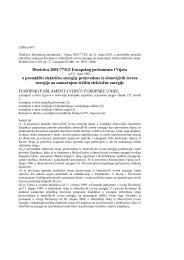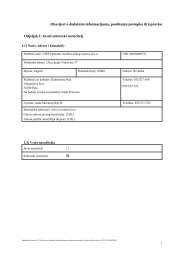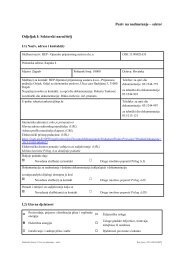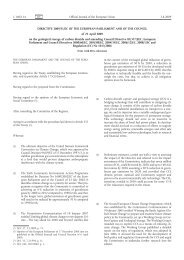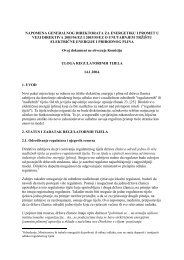- Page 2 and 3:
05/07ENERGIJAIZDAVA»Hrvatska elekt
- Page 4 and 5:
UVODINTRODUCTIONDragi Ëitatelji,u
- Page 6:
ULOGA REGULATORNOG TIJELA UDONO©EN
- Page 9 and 10:
U radu Okruglog stola po pozivu su
- Page 11 and 12:
azdvajanja energetskih djelatnosti,
- Page 13 and 14:
3 RESTRUKTURIRANJEELEKTROENERGETSKO
- Page 15 and 16:
nizma, ukljuËujuÊi i sadræaje i
- Page 17 and 18:
Tarifni sustav /Tariff systemSlika
- Page 19 and 20:
Stopa povrata koja omoguÊuje nakna
- Page 21 and 22:
Troškovi poslovanja /Operational c
- Page 23 and 24:
znati polugodiπnji ukupni troπkov
- Page 25 and 26:
dræava i njihovih odgovarajuÊih e
- Page 27 and 28:
ili naroËito u sluËajevima kada s
- Page 29 and 30:
metode regulacije i metodologije ta
- Page 31 and 32:
Na spomenuti kontekst ulaganja u od
- Page 33 and 34:
greater cooperation and the transfe
- Page 37 and 38:
Hrvatska je na poËetku uvoappleenj
- Page 39:
∑ treba li regulatorno tijelo bit
- Page 42 and 43: izraappleuje temeljem Strategije en
- Page 44 and 45: P max (t - 1) ∑ gornja granica do
- Page 46 and 47: azina investicija ukljuËiti u regu
- Page 48 and 49: je porast potroπnje te zamjena pos
- Page 50 and 51: Tablica 3 ∑ Pojednostavljen primj
- Page 52: eguliranih cijena. Stabilna razina
- Page 55 and 56: 4.2.1 Iskustva VijeÊa za regulacij
- Page 57 and 58: 4.2.2 Iskustva Hrvatske energetske
- Page 59 and 60: zakonskih akata, provede sve nuæne
- Page 61 and 62: latornog tijela tijekom procesa utv
- Page 63 and 64: LITERATURA / REFERENCES[1] Zakon o
- Page 66 and 67: 1 UVODU niskofrekvencijske prijelaz
- Page 68 and 69: Slika 1Krivulja magnetiziranjatrans
- Page 70 and 71: 2 MATEMATI»KI MODELPRI UKLAPANJUNE
- Page 72 and 73: Slika 5Uklapanjetransformatora ∑p
- Page 74 and 75: Kada se odrede konstante a, b i c t
- Page 76 and 77: 4 NUMERI»KI PRISTUPSada Êe se ana
- Page 78 and 79: Tada je opÊe rjeπenje jednadæbe
- Page 80 and 81: gdje su:where:(31a)(31b)Implicitno
- Page 82 and 83: 5 TEST PRIMJERProgrami dobiveni pre
- Page 84 and 85: (36)(37)gdje su:j = 1, 2, 3 oznake
- Page 86 and 87: 7 ZAKLJU»AKU radu je opisan model
- Page 88: DIJAGNOSTI»KI PREGLEDRASPADA ELEKT
- Page 91: Slika 1Jednopolna shemasustava na p
- Page 95 and 96: Slika 7Oscilogram 5 ∑ Naponna sab
- Page 97 and 98: LITERATURA / REFERENCES[1] Internal
- Page 100 and 101: 1 UVODSustavi relejne zaπtite u el
- Page 102 and 103: ∑ Ëesti problem sliËnih baza po
- Page 104 and 105: slike (npr. jednopolne sheme), dija
- Page 106 and 107: Pojedinim korisnicima u ovoj grupi
- Page 108 and 109: · opis svih relacija u bazi podata
- Page 110 and 111: Slika 4IzvjeπÊe o udeπenjuzaπti
- Page 112 and 113: 7 ZAKLJU»AKRazvoj i odræavanje in
- Page 114 and 115: UPUTSTVO ZA RUKOPISUPUTEAUTORIMA1.
- Page 117: DIJAGNOSTI»KI PREGLEDRASPADA ELEKT
- Page 120 and 121: Slika 1Jednopolna shemasustava na p
- Page 122 and 123: 2.7951.3980-1.398-2.7952.7951.3980S
- Page 124 and 125: Slika 7Oscilogram 5 ∑ Naponna sab
- Page 126 and 127: LITERATURA / REFERENCES[1] Internal
- Page 129 and 130: 1 UVODU niskofrekvencijske prijelaz
- Page 131 and 132: Slika 1Krivulja magnetiziranjatrans
- Page 133 and 134: 2 MATEMATI»KI MODELPRI UKLAPANJUNE
- Page 135 and 136: Slika 5Uklapanjetransformatora ∑p
- Page 137 and 138: Kada se odrede konstante a, b i c t
- Page 139 and 140: 4 NUMERI»KI PRISTUPSada Êe se ana
- Page 141 and 142: Tada je opÊe rjeπenje jednadæbe
- Page 143 and 144:
gdje su:where:(31a)(31b)Implicitno
- Page 145 and 146:
5 TEST PRIMJERProgrami dobiveni pre
- Page 147 and 148:
(36)(37)gdje su:j = 1, 2, 3 oznake
- Page 149 and 150:
7 ZAKLJU»AKU radu je opisan model
- Page 151:
REGULATORNA POLITIKA I NJENUTJECAJ
- Page 154 and 155:
Hrvatska je na poËetku uvoappleenj
- Page 156 and 157:
∑ treba li regulatorno tijelo bit
- Page 158 and 159:
U Bugarskoj se financijski nadzor p
- Page 160 and 161:
ZakljuËak koji se moæe izvuÊi iz
- Page 162 and 163:
no tijelo na osnovi troπka kapital
- Page 164 and 165:
Tablica 1 ∑ Pojednostavljen primj
- Page 166 and 167:
nih razdoblja. Ukoliko je energetsk
- Page 168 and 169:
Problem koji se javlja u regulatorn
- Page 170 and 171:
Naime, bitno je napomenuti da je HE
- Page 172 and 173:
4.2.1 Iskustva VijeÊa za regulacij
- Page 174 and 175:
4.2.2 Iskustva Hrvatske energetske
- Page 176 and 177:
zakonskih akata, provede sve nuæne
- Page 178 and 179:
latornog tijela tijekom procesa utv
- Page 180 and 181:
LITERATURA / REFERENCES[1] Zakon o
- Page 183 and 184:
1 UVODNa inicijativu SO C5 ∑ Træ
- Page 185 and 186:
koji se primjenjuju na davanje odob
- Page 187 and 188:
je sluËaj da regulatorno tijelo im
- Page 189 and 190:
integralnog tarifnog sustava koji j
- Page 191 and 192:
Slika 1Restrukturiranjeelektroenerg
- Page 193 and 194:
zatim s vremenom, kako su svi sudio
- Page 195 and 196:
Slika 5Tarifni sustav zaprijenos el
- Page 197 and 198:
knjigovodstvenog praÊenja po izdvo
- Page 199 and 200:
ma, kod svih regulatornih tijela i
- Page 201 and 202:
7) Regulatorna tijela imaju vaænu
- Page 203 and 204:
træiπta, odnosno razvoja i uspost
- Page 205 and 206:
tuacijama regulatorna tijela postup
- Page 207 and 208:
5 ZAKLJU»AKOkrugli stol o ulozi re
- Page 210 and 211:
05/07ENERGIJAIZDAVA»Hrvatska elekt
- Page 212 and 213:
UVODINTRODUCTIONDragi Ëitatelji,u
- Page 214:
ULOGA REGULATORNOG TIJELA UDONO©EN
- Page 217 and 218:
U radu Okruglog stola po pozivu su
- Page 219 and 220:
azdvajanja energetskih djelatnosti,
- Page 221 and 222:
3 RESTRUKTURIRANJEELEKTROENERGETSKO
- Page 223 and 224:
nizma, ukljuËujuÊi i sadræaje i
- Page 225 and 226:
Tarifni sustav /Tariff systemSlika
- Page 227 and 228:
Stopa povrata koja omoguÊuje nakna
- Page 229 and 230:
Troškovi poslovanja /Operational c
- Page 231 and 232:
znati polugodiπnji ukupni troπkov
- Page 233 and 234:
dræava i njihovih odgovarajuÊih e
- Page 235 and 236:
ili naroËito u sluËajevima kada s
- Page 237 and 238:
metode regulacije i metodologije ta
- Page 239 and 240:
Na spomenuti kontekst ulaganja u od
- Page 241 and 242:
greater cooperation and the transfe
- Page 244 and 245:
1 UVODU prosincu 2006. godine Hrvat
- Page 246 and 247:
poveÊanje uËinkovitosti, odnosno
- Page 248 and 249:
Pitanja koja su zanimljiva za ulogu
- Page 250 and 251:
izraappleuje temeljem Strategije en
- Page 252 and 253:
P max (t - 1) ∑ gornja granica do
- Page 254 and 255:
azina investicija ukljuËiti u regu
- Page 256 and 257:
je porast potroπnje te zamjena pos
- Page 258 and 259:
Tablica 3 ∑ Pojednostavljen primj
- Page 260 and 261:
eguliranih cijena. Stabilna razina
- Page 262 and 263:
4.2 Kriteriji za davanje suglasnost
- Page 264 and 265:
πto je u skladu s prijedlogom Mre
- Page 266 and 267:
Jedan od bitnih preduvjeta za mogu
- Page 268 and 269:
5 ZAKLJU»AKU utvrappleivanju regul
- Page 270 and 271:
prihvaÊene metode priznatih troπk
- Page 272:
NUMERI»KI PRORA»UNNISKOFREKVENCIJ
- Page 275 and 276:
Kao πto je veÊ spomenuto, osnovna
- Page 277 and 278:
Slika 2Nesinusoidalnastruja magneti
- Page 279 and 280:
jezgre transformatora L m , inaËe
- Page 281 and 282:
(9)(10)(11)Napon U 0 i struja I C0
- Page 283 and 284:
Pojednostavljeni algoritam raËunan
- Page 285 and 286:
gdje su konstante a i, i = 0, 1, 2,
- Page 287 and 288:
dobiva se jednadæba u prostoru sta
- Page 289 and 290:
PoËetakUËitavanjeparametara susta
- Page 291 and 292:
Struja transformatora / Transformer
- Page 293 and 294:
(38)Rezultati mjerenja i simulacija
- Page 295 and 296:
LITERATURA / REFERENCES[1] CIPCIGAN
- Page 298 and 299:
1 UVODIzolirani otoËni elektroener
- Page 300 and 301:
2 ANALIZA INCIDENTAKako sustavu SCA
- Page 302 and 303:
Slika 4Oscilogram 2 ∑Struje zabil
- Page 304 and 305:
3 ZAKLJU»CIElektroenergetski susta
- Page 306:
BAZA PODATAKARELEJNE ZA©TITERELAY
- Page 309 and 310:
zaπtite povremeno mijenjaju noviji
- Page 311 and 312:
ogatim, prirodnim i korisniku blisk
- Page 313 and 314:
Slika 1Dio relacijske shemebaze pod
- Page 315 and 316:
je omoguÊiti korisniku πto lakπe
- Page 317 and 318:
Slika 2Sloæena ekranska formaFigur
- Page 319 and 320:
6 TESTIRANJE BAZEPODATAKA I OBUKAKO
- Page 321 and 322:
LITERATURA / REFERENCES[1] MCCLAIN,
- Page 323:
MANUSCRIPTS1. Energija journal publ






